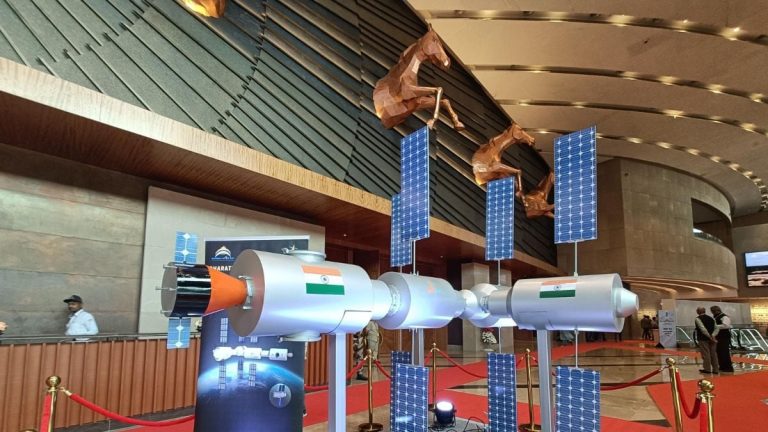
A model of the Bharatiya Antaliksh station on display at the National Space Day event in New Delhi on Friday.
The space station will have five different modules (weighing up to 10 tons) that will fly into space on the next-generation rocket Soorya and eventually dock as a complete unit in 2035
Station Director S Somanath said that the Bharatiya Antariksh space station will have as many as five modules and the first basic module will be launched by the Indian Space Research Organization (ISRO) in 2028. The entire space station has a mass of about 52 tons and is expected to be fully assembled in space by 2035.
The first module, with a mass of approximately 9186 kg, will not have any manned re-entry capabilities and will be robotic. “This will be the smallest of all five modules that can be installed into our current rocket, the LVM Mk-3. Once launched, we will build the remaining larger modules over the next few years. Our plan is With as many as five modules, all the modules will then be docked in space,” the ISRO chairman said on the sidelines of National Space Day in New Delhi.
ISRO is also building a new generation rocket, Soorya, to lift off heavier modules. It has twice the capability of the current heaviest rocket, the LVM Mk-3, which can carry satellites up to 4 tons to geosynchronous orbit and satellites up to 10 tons to low Earth orbit (LEO). India has set a timetable for assembling the entire space station in phases by 2035, which will then accommodate 3-4 astronauts at different times to conduct multiple experiments in space.
“The space station is supported through international cooperation. We have been involved in the construction of the International Space Station, so we hope that when we build our space station, other countries will also participate and jointly carry out missions.
Chandrayaan-3 to collect lunar samples in 2027
ISRO is also eyeing the moon, with the next phase of the Chandrayaan mission likely to be launched in 2027 to collect and bring back lunar samples. It will also demonstrate the agency's space docking capabilities.
“This mission requires different technologies that allow us to escape the moon's gravity, orbit the moon, and then re-enter the Earth without being burned up. It is very challenging. But if we have to send humans by 2040, Moon, we need to develop this capability.
To commemorate the first anniversary of its historic landing near the moon's south pole, ISRO has also made the data collected by the Chandrayaan-3 mission available to the public. Space researchers from around the world can download and access it from the agency's website.
“There are still some fundamental questions about the origin of the Moon, and whether it will provide some clues about the formation of the Earth itself. Also, can we create a habitable space on the lunar surface? We have been working hard to understand all aspects, Chandrayaan The team has made new discoveries showing volcanic activity occurring on the moon,” he added.
The space agency also announced a statement on “zero-debris missions” and urged other countries to follow suit. “We have to keep launching satellites, but we have also decided not to litter space with junk. So once the satellites are out of service, we will bring them to Earth and make sure there are no collisions or explosions in space.
